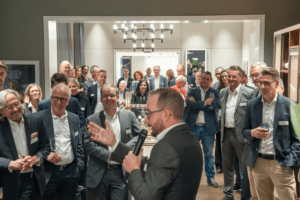Dubai, UAE – October 10, 2024 The Abrahamic Business Circle, is excited to announce its upcoming flagship conference, “Innovating for a Greener Tomorrow.” The event will take place on December 12, 2024, in Dubai, United Arab Emirates. This exclusive gathering will bring together industry leaders, investors, policymakers, and innovators to explore how technology, innovation, and collaboration can shape a better future for the Middle East and beyond.
This event comes at a critical time as the Middle East experiences transformative growth across various sectors, from technology and education to infrastructure and economic development. Dubai, in particular, is positioning itself as a global hub for innovation, making it the ideal location for this high-profile event.
Why Dubai is Leading in Innovation
Dubai has always been a beacon of progress and ambition in the region, with a clear vision to become a global leader in innovation, sustainability, and economic growth. Significant investments in infrastructure, technology, and human capital are positioning Dubai as a city that embraces the future. The Abrahamic Business Circle recognizes this transformation and aims to bring together key players from various industries to discuss opportunities, explore new technologies, and accelerate the region’s transition to a brighter, more prosperous future.
Dr. Raphael Nagel, Founder and Chairman of The Abrahamic Business Circle, emphasizes the importance of this moment: “The Middle East is at the forefront of a new era of growth and innovation. Technology and collaboration are the driving forces shaping our future. Now is the time for global leaders to come together and seize the opportunities that will build a better tomorrow.”
A Visionary Gathering: What to Expect
The “Innovating for a Greener Tomorrow” conference promises to be an event that fosters collaboration and brings together the best minds to discuss critical topics in economic development, technological innovation, and sustainability. High-level speakers, panel discussions, and networking opportunities will provide a platform for meaningful dialogue.
Attendees will engage in discussions about the future of various industries in the Middle East, explore investment opportunities, and learn about the latest advancements in technology and sustainable development. The conference is designed to facilitate partnerships between government leaders, business executives, and academics who can work together to develop long-term solutions for the challenges of tomorrow. Key topics will include the economic impact of innovation in the Middle East, strategies for boosting investments in various sectors, and frameworks for encouraging technological advancements and sustainable growth.
The Abrahamic Business Circle’s Commitment to Sustainable Development
At the heart of The Abrahamic Business Circle’s mission is a commitment to advancing economic diplomacy and promoting sustainable development through business collaboration. Since its founding, the organization has built a global network of entrepreneurs, investors, corporations, and diplomats from 56 countries, all working together to drive sustainable economic growth. The Circle’s flagship events provide members with unparalleled access to investment opportunities and strategic partnerships across industries and geographies.
Dr. Raphael Nagel highlights the Circle’s role in fostering unity through economic collaboration: “We are committed to creating a platform where countries and leaders can come together to work towards a better future. Our focus is on achieving economic success that leads to long-lasting partnerships and positive change.
“The upcoming “Innovating for a Greener Tomorrow” conference aligns perfectly with this vision, as it seeks to address some of the most pressing global challenges—from economic growth to social progress. By bringing together global leaders to discuss innovative solutions and strategies, the Circle continues its mission of fostering dialogue and collaboration for the benefit of the world.
Join Us in Shaping the Future
We invite government officials, business leaders, investors, and academics from across the globe to join us in Dubai on December 12, 2024, for this landmark event. Together, we can shape a brighter, more sustainable future by exploring innovative solutions, investing in key sectors, and building partnerships that drive positive change.
This event offers an invaluable opportunity to network with industry leaders, gain insights into the latest technological advancements, and explore investment opportunities in various sectors. Whether you are an experienced investor or a business leader looking to expand your network, “Innovating for a Greener Tomorrow” is an event you cannot afford to miss.
For more information and to register, visit:
www.theabrahamicbusinesscircle.com
Contact:
The Abrahamic Business Circle
Email: contact@theabrahamicbusinesscircle.com
LinkedIn: www.linkedin.com/theabrahamicbusinesscircle
Don’t miss your chance to be part of this groundbreaking discussion on the future of innovation, economic growth, and sustainable development. Join us in Dubai and help pave the way for a brighter tomorrow.
Legal Notice:
PressLink distributes this press release on an “as-is” basis without any express or implied warranties. PressLink expressly disclaims any responsibility or liability for the accuracy, content, images, videos, licenses, completeness, legality, or reliability of the information presented in this article. Any complaints, copyright issues, or concerns regarding this article should be addressed directly to the author.
Disclaimer:
This content was neither written nor endorsed by PressLink and does not reflect the views of PressLink, its advertisers, or affiliates. For inquiries or corrections regarding press releases, please contact PressLink directly.













